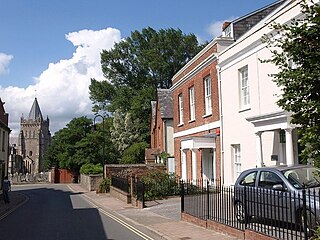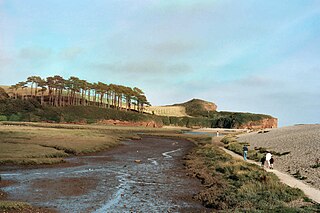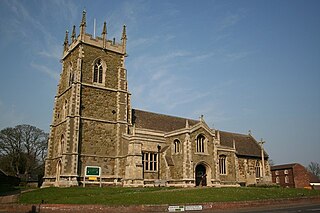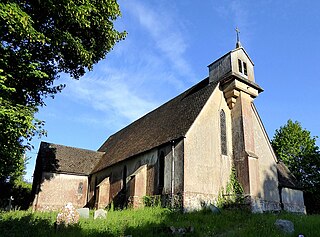Related Research Articles

A pixie is a mythical creature of British folklore. Pixies are considered to be particularly concentrated in the high moorland areas around Devon and Cornwall, suggesting some Celtic origin for the belief and name.

Ottery St Mary, known as "Ottery", is a town and civil parish in the East Devon district of Devon, England, on the River Otter, about 10 miles (16 km) east of Exeter on the B3174. At the 2001 census, the parish, which includes the villages of Metcombe, Fairmile, Alfington, Tipton St John, Wiggaton, and West Hill, had a population of 7,692. The population of the urban area alone at the 2011 census was 4,898.

Burford is a town on the River Windrush, in the Cotswold hills, in the West Oxfordshire district of Oxfordshire, England. It is often referred to as the 'gateway' to the Cotswolds. Burford is located 18 miles (29 km) west of Oxford and 22 miles (35 km) southeast of Cheltenham, about 2 miles (3 km) from the Gloucestershire boundary. The toponym derives from the Old English words burh meaning fortified town or hilltown and ford, the crossing of a river. The 2011 Census recorded the population of Burford parish as 1,422.

The River Otter is a river that rises in the Blackdown Hills just inside the county of Somerset, England near Otterford, then flows south through East Devon. It enters the English Channel at the western end of Lyme Bay, part of the Jurassic Coast, a UNESCO World Heritage Site. The Permian and Triassic sandstone aquifer in the Otter Valley is one of Devon's largest groundwater sources, supplying drinking water to 200,000 people.

Rocamadour is a commune in the Lot department in southwestern France. It lies in the former province of Quercy.

John Coleridge Patteson was an English Anglican bishop, missionary to the South Sea Islands, and an accomplished linguist, learning 23 of the islands' more than 1,000 languages.

North Petherwin is a civil parish and village in the historic county of Devon and the ceremonial county of Cornwall, England, United Kingdom. The village is situated five miles (8 km) northwest of Launceston on a ridge above the River Ottery valley.

The King's School is a secondary school and sixth form located in Ottery St Mary, Devon, England. It was established as a choir school by the bishop John Grandisson in 1335, but was replaced by a grammar school by Henry VIII in 1545. It became a comprehensive school in 1982, and an academy in 2011. The school's pupils are mainly drawn from its five feeder primaries in the surrounding area: Ottery St Mary primary school, West Hill Primary School, Payhembury Church of England Primary School, Feniton Church of England Primary School and Tipton St John Church of England Primary School.

Geoffrey Duke Coleridge, 3rd Baron Coleridge was responsible for making the archive of his family member the poet Samuel Taylor Coleridge available to researchers for the first time.

Taunton Minster (St Mary Magdalene church) is a Church of England parish minster church in Taunton, Somerset, England, dedicated to Jesus' companion Mary Magdalene. It was completed in 1508 and is in the Early Tudor Perpendicular Gothic style. It is designated as a Grade I listed building. It is notable for its very tall tower.
Songs of the Pixies was composed by Samuel Taylor Coleridge during 1793. The poem describes Coleridge's summer vacation and his childhood home. It also incorporates Coleridge's own view of himself as a young poet.

St Wilfrid's, Alford is the Church of England parish church in Alford, Lincolnshire, England. It is a Grade I listed building.

The Parish Church of St Mary with Holy Trinity, more commonly known as St Mary's Church, is the civic church for the city of Southampton, Hampshire, England. Originally founded in circa 634, St Mary's has been the mother church of Southampton since its inception. The present building, now the sixth incarnation of a church on this site, dates mostly to a rebuilding from 1954 to 1956, following its destruction in the Southampton Blitz, except for the notable Grade II listed tower and spire, which date from 1912 to 1914.

The Rt Rev William Hart Coleridge was the first Bishop of Barbados from 1824 until 1842.

St Mary's Church is a Grade I listed building, a parish church in the Church of England in Ottery St Mary, Devon.
Thorne in the parish of Ottery St Mary in Devon is an historic estate situated on the west side of the River Otter opposite the town of Ottery St Mary. The site is today occupied by Thorne Farm situated to the immediate north of the town's school and hospital and to the immediate south of the surviving early 17th century grand mansion house of Cadhay.

St James' and St Anne's Church is a Church of England church in Alfington, Devon, England. It was built in 1849 at the expense of Sir John Taylor Coleridge and designed by William Butterfield.

St Edward's Church is a Church of England church in Wiggaton, Devon, England. It was constructed in 1892–93 and designed by the Exeter architect Edward G. Warren. The church has been Grade II listed since 1952.

The Suffolk Guild of Ringers for the Diocese of St Edmundsbury and Ipswich is a society and charity supporting the bell ringers and rings of bells in the Diocese of St Edmundsbury and Ipswich who practice the art of change ringing. The Guild was established on 2 April 1923 at Ipswich and covers over 200 rings of bells in the county of Suffolk in the area that falls within the diocese boundary.
Lazy Laurence is a pixie and nature spirit in English folklore who inhabits the New Forest area of Hampshire and Dorset. He is traditionally associated with the protection of orchards and of cider, and known to send people to sleep beneath fruit trees, make them lazy, make them dither, or to give them stomach cramps.
References
- ↑ "Events". Ottery St. Mary Tourist Information Centre. 2010. Archived from the original on 20 January 2010.
- 1 2 The pixies' revenge; or, the threat to the bells of St. Mary's Church, Ottery, RF Delderfield, pub. EJ Manley of Ottery St. Mary, 1954
- ↑ Coleridge: a collection of critical essays, ed. Kathleen Coburn, Prentice-Hall, 1967
- ↑ Ottery St Mary – The Coleridge Link, Coleridge Memorial Project website.